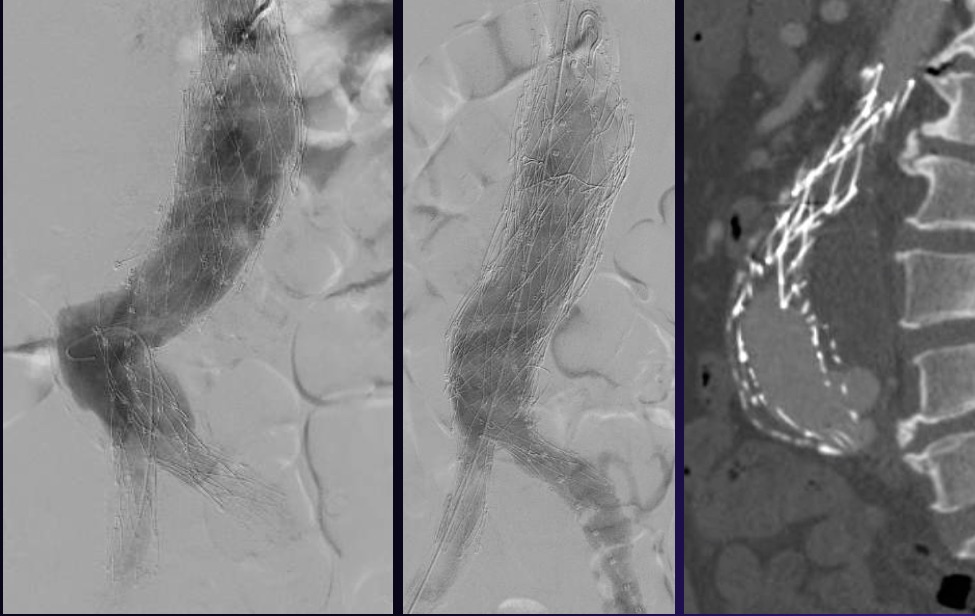

The therapeutic algorithm for all endoleaks will continue as described in this manuscript. Embolisation plays a small, but significant role in the management of challenging type 1 endoleaks after EVAR and TEVAR if no other endovascular solution is feasible. Embolisation plays a key role in the treatment of type 2 endoleaks and EVAR and TEVAR. Many of the therapeutic options require the insertion of additional endografts in conjunction with additional endovascular methods, e.g.

The primary therapy for type 1, 2 and 3 endoleaks after EVAR and TEVAR involves endovascular methods in the majority of cases. 2017 65(2).ĭ: Two Messages About Endoleak Management Following TEVAR and EVARġ. Early and midterm outcomes after transcatheter embolization of type I endoleaks in 25 patients. Editor’s Choice – Systematic Review and Meta-Analysis of the Outcome of Treatment for Type II Endoleak Following Endovascular Aneurysm Repair.

Ultee KHJ, Büttner S, Huurman R, Bastos Gonçalves F, Hoeks SE, Bramer WM, et al. A meta-analysis of translumbar embolization versus transarterial embolization for type II endoleak after endovascular repair of abdominal aortic aneurysm. Guo Q, Zhao J, Ma Y, Huang B, Yuan D, Yang Y, et al. Embolisation of left subclavian artery associated type 2 endoleaks has a technical and clinical success of 100%.ġ. Type 1 endoleaks occur in 3.3–16% after TEVAR, and type 2 endoleaks occur in 3.3% of all TEVAR cases. Regarding outcomes of embolisation for type 2 endoleaks, a recent review indicated that the technical success rate for direct sac puncture embolisation (81%) is higher than transarterial embolisation (63) and a lower rate of recurrence (19% vs 36%). The combined approach of DUS, CTA and MRI detects and characterises secondary endoleaks in 91% of cases.Įmbolisation has a technical success above 95% and mid-term success of 80% for EVAR EL1a.Įmbolisation of type 2 endoleaks is indicated for an increase in sac size of 5 mm on sequential imaging. The outcomes of type 2 embolisation in experienced hands are very good if experts select the appropriate embolisation method for the specific patient anatomy and perform a technically complete embolisation.Įmbolisation has a small but defined role in the management of endoleaks after TEVAR.ī: Five Most Important Numbers with Respect to Endoleak Management After EVAR and TEVAR Techniques for catheterising the endoleak sac in EL2 include transarterial, transiliac paraendograft, direct sac puncture and transcaval embolisation.Įmbolisation agents for both EL1 and EL2 embolisation include coils, and liquid embolics, including Onyx, glue and thrombin. The main endovascular therapeutic options for EL1 include EndoAnchors, aortic cuffs and embolisation.ĮL2 are low pressure, often benign and only warrant treatment if associated with a sac size increase of at least 5 mm.Īn occult EL1 and E元 should be considered and excluded when facing a suspected EL2 with increasing sac size.Įmbolisation is the mainstay treatment for EL2 with increasing sac size A: Ten Most Important Points Regarding Secondary Endoleak Management Following TEVAR and EVARĬTA is the main imaging investigation for assessing and characterising secondary endoleaks.ĮL1 endoleaks are high pressure and require prompt treatment.


 0 kommentar(er)
0 kommentar(er)
